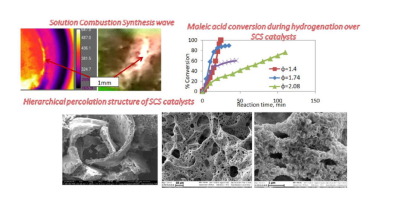Journal of Catalysis ( IF 6.5 ) Pub Date : 2018-05-31 , DOI: 10.1016/j.jcat.2018.04.003 G. Xanthopoulou , O. Thoda , S. Roslyakov , A. Steinman , D. Kovalev , E. Levashov , G. Vekinis , A. Sytschev , A. Chroneos

|
The structure, composition, surface area and catalytic activity of Solution Combustion Synthesis (SCS) catalysts are all influenced by the conditions of preparation and in particular, the glycine concentration in the initial SCS solution. NMR was used to monitor the formation of glycine-nickel nitrate complexes in solution before SCS initiates, IR high speed temperature measurements have allowed to elucidate the mechanism of synthesis during SCS, dynamic X-ray analysis and thermogravimetric analysis have clarified the mechanisms of phase formation during SCS, BET analyses have shown the regularity of pore formation and SEM and TEM studies have indicated the regularities involved during microstructure formation. Regular three-dimensional (3D) flowerlike Ni-NiO hierarchical architectures were synthesized by SCS. The results have revealed a three-dimensional percolation network with hierarchical structure on the basis of nano-structured metal oxides and metals synthesized during SCS. Such hierarchically nanoporous catalysts have versatile structural properties such as increased surface area and large overall pore volume that can alleviate diffusional limitations of conventional nanocatalysts with solely microporous framework. This is important for liquid phase heterogeneous catalysis. These new insights provide a valuable capability for optimizing the selectivity and activity of SCS catalysis and will no doubt be of significant interest to a wide range of researchers working in catalysis and other fields.
中文翻译:

具有分级结构的纳米催化剂的固溶燃烧合成
溶液燃烧合成(SCS)催化剂的结构,组成,表面积和催化活性均受制备条件的影响,特别是受初始SCS溶液中甘氨酸浓度的影响。在SCS启动之前,使用NMR监测溶液中甘氨酸-硝酸镍络合物的形成,IR高速温度测量可以阐明SCS期间的合成机理,动态X射线分析和热重分析已阐明了相形成的机理。在SCS期间,BET分析显示了孔形成的规律性,而SEM和TEM研究表明了在微结构形成过程中的规律性。SCS合成了规则的三维(3D)花状Ni-NiO层次结构。结果显示了基于纳米结构的金属氧化物和在SCS期间合成的金属的具有分层结构的三维渗流网络。这样的分级纳米孔催化剂具有通用的结构性质,例如增加的表面积和大的总孔体积,这可以减轻仅具有微孔骨架的常规纳米催化剂的扩散限制。这对于液相非均相催化很重要。这些新见解为优化SCS催化的选择性和活性提供了宝贵的能力,并且无疑将引起在催化和其他领域工作的众多研究人员的极大兴趣。这样的分级纳米孔催化剂具有通用的结构性质,例如增加的表面积和大的总孔体积,这可以减轻仅具有微孔骨架的常规纳米催化剂的扩散限制。这对于液相非均相催化很重要。这些新见解为优化SCS催化的选择性和活性提供了宝贵的能力,并且无疑将引起在催化和其他领域工作的众多研究人员的极大兴趣。这样的分级纳米孔催化剂具有通用的结构性质,例如增加的表面积和大的总孔体积,这可以减轻仅具有微孔骨架的常规纳米催化剂的扩散限制。这对于液相非均相催化很重要。这些新见解为优化SCS催化的选择性和活性提供了宝贵的能力,并且无疑将引起在催化和其他领域工作的众多研究人员的极大兴趣。











































 京公网安备 11010802027423号
京公网安备 11010802027423号